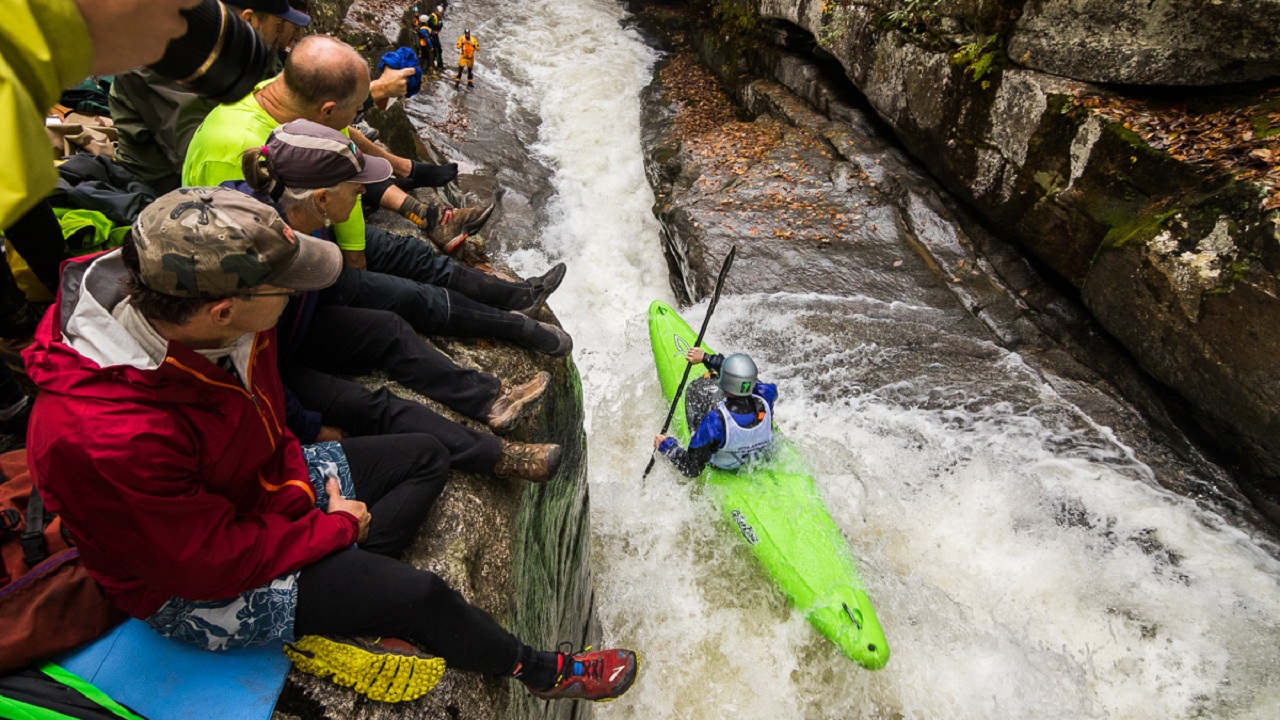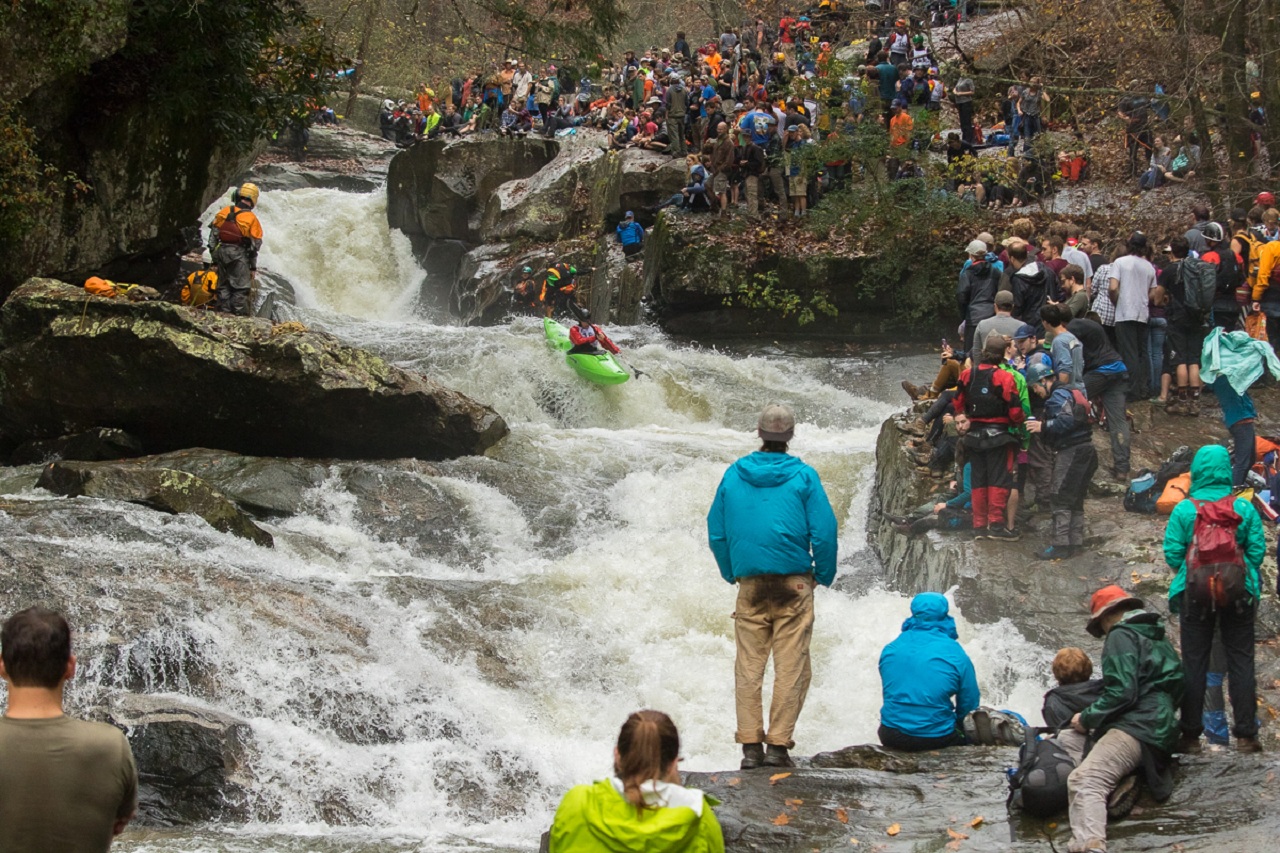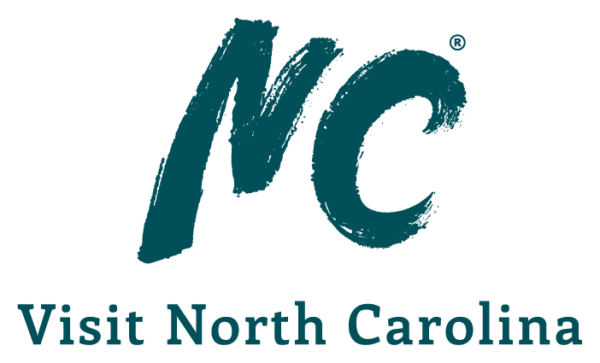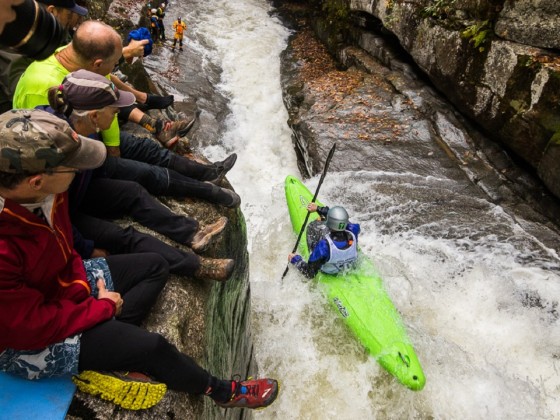AS A PADDLER, YOU OPERATE ON FLOW. Your best lines come when there’s a certain effortlessness beneath all the adrenaline and movement. Where the river is turbulence and chaos, you find — you become — a point of stillness.
The Green River Narrows, in southwestern North Carolina, really begins at a rapid called Frankenstein. I could hear the roar below the drop. All the nerves I was feeling in the ride over suddenly evaporated and it was just paddle strokes. I lined up through the entrance, caught a couple of tight eddies, and peeled out. I’d nailed my line.
And so I dropped through the next couple of smaller rapids feeling relaxed, as if able to slow down the motion of the whitewater — the foam and colors, the deep forested gorge almost dissolving together into a single abstract and perfectly beautiful terrain. It was a June day with warm-enough water temps that you didn’t need a drytop. I was in the flow.
But somehow as I entered the next big rapid, Boof or Consequences, I missed a paddle stroke on my right side. The nose of my kayak rode up and “splatted” the wall of the narrow slot. This was a dangerous place to mess up. You had to pass through the entrance cleanly in order to “boof” (launch) over the six foot main falls. The “consequences” for a missed boof was (among other things) the shallow shelf below. A total headbreaker if you were upside down. This was what separated the Green from most of the other runs I’d done up until then. Whereas on most rivers boofing was just a fun way to get extra air, on the Green it was a mandatory skill — the difference between running rapids in or out of control.

Alec Voorhees boofing Scream Machine rapid. Photo by John Webster
In that instant of getting splatted up higher and higher — nearly vertical now — I felt a strange calmness. An instinct not to flail and force my boat anywhere. Since I’d already blown my line, I just let the flow take me up and over. I had a surreal view, looking up vertically now through the blue sky walled in on either side by the gorge. Then I flipped. I knew I was in a bad place.
I tucked as tightly as I could, but felt myself hit the lip of the drop with my shoulder (crunch!) and then go over the falls upside down.
I held my breath and — still in slow motion — waited for a huge impact, a crushing blackness, whatever was about to come.

Paddler going off Gorilla rapid. Photo by John Webster
Amazingly, I felt the kayak level back up to the surface in the pool below. I rolled up to big cheers and an overpowering sense of relief and calm. Somehow I’d escaped major consequences. But I was definitely woken up from my relaxed state.
This is what you learned to love about the Narrows. It demanded respect. It punished complacency. And yet you could (if you were lucky) get a second chance. It had never-before-run lines and moves that could fire up your imagination, and yet so many consequences that it kept you totally honest with yourself. Just being there was an honor, a reflection of years of skill building.
For most of us in the South, this meant progressing through roll classes in pools or lakes (and for me, this included summer camp days on Lake Summit, the very water which emptied into the Green). It meant class I-II runs on the Chattahoochee, then on to the Nantahala, the lower Green, then the Ocoee. The Chattooga. The Narrows took all of your paddling foundation and tested it in the most classic Southern steep creek terrain imaginable: super steep, shallow, drop-pool rapids with must-make moves throughout. And uniquely, it was dam-controlled, which meant that unlike nearly every other class V creek in the country, it had a consistent, reliable level some 300 days a year.
In the two decades since my first run, I’ve watched an amazing community build up around the Green. People literally move here (to the Asheville area) so they can paddle it year round. It’s like a paddler’s Pipeline on the North Shore. One of the leading kayaking manufacturers (Liquid Logic) has developed right in nearby Flat Rock and owes its designs to having the Green as its testing ground. This is true for several local Asheville whitewater accessory brands such as Astral and Watershed as well.

Paddler boofing Scream Machine Rapid. Photo by John Webster
Perhaps more than anything, what’s made the Green famous is the Green Race. Held the first Saturday of November each year since 1996, the Green Race is the most hardcore whitewater event in the country. Originally just an informal race among the local boaters at the time, the event has blown up into an international competition. And it’s arguably the sporting event that takes the most commitment on behalf of spectators, who have to hike down a steep trail into the Narrows and view from very slippery, dangerous areas above the biggest rapid, Gorilla.
Each year sees epic lines as racers come through Gorilla, as well as terrible beatdowns. Check some of the footage from the 2015 race:
For the past four years, a new competition has emerged as well, the Green River Games, a multisport event including mountain biking, trail running, and kayaking.
The Green is found in the Green River Game Lands, a 14,000-acre wilderness area owned by the people of North Carolina and managed by NCWRC. It’s near the small town of Saluda, North Carolina (home to what was once the steepest railroad grade in the country). It’s easily accessible from Asheville (about 40 minutes away), but feels remarkably remote once you’re in there. This is partly due to the wildlife conservation policies (trails are restricted to foot travel only and there’s no camping within the Game Lands), and partly due to the steep topography of the Blue Ridge escarpment and general ruggedness of the terrain. Wildlife is abundant in the Game Lands, with a high species diversity (31 species) of native fish, plenty of mammals (including river otter and bear), and a plethora of birds (the Game Lands is also part of the NC Birding Trail).
For camping, the closest area is Wilderness Cove, a mile or so past Fishtop access.

